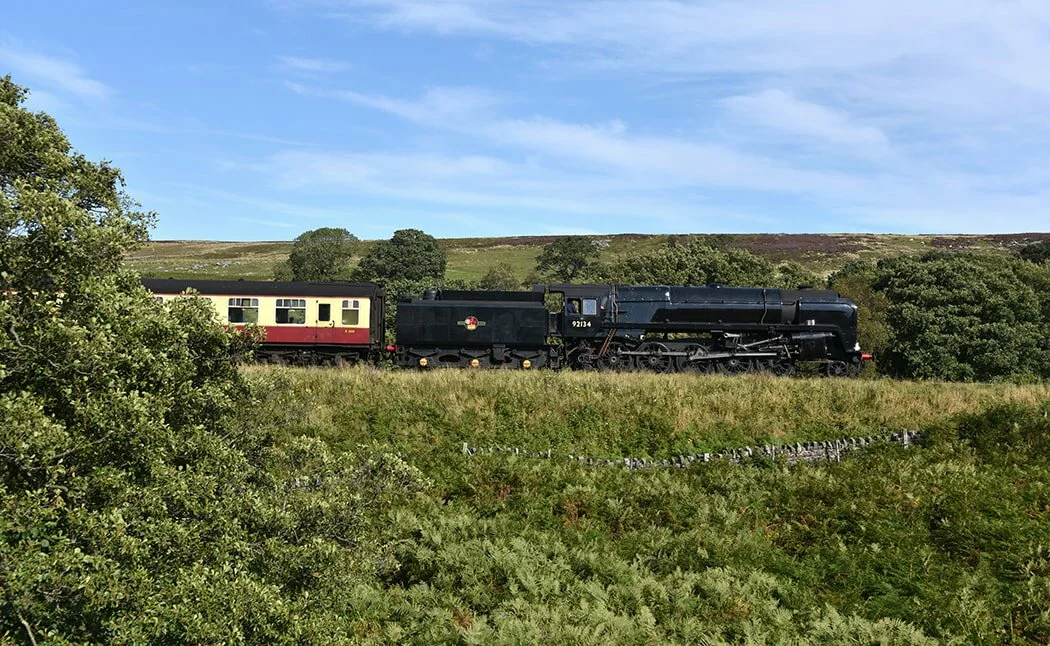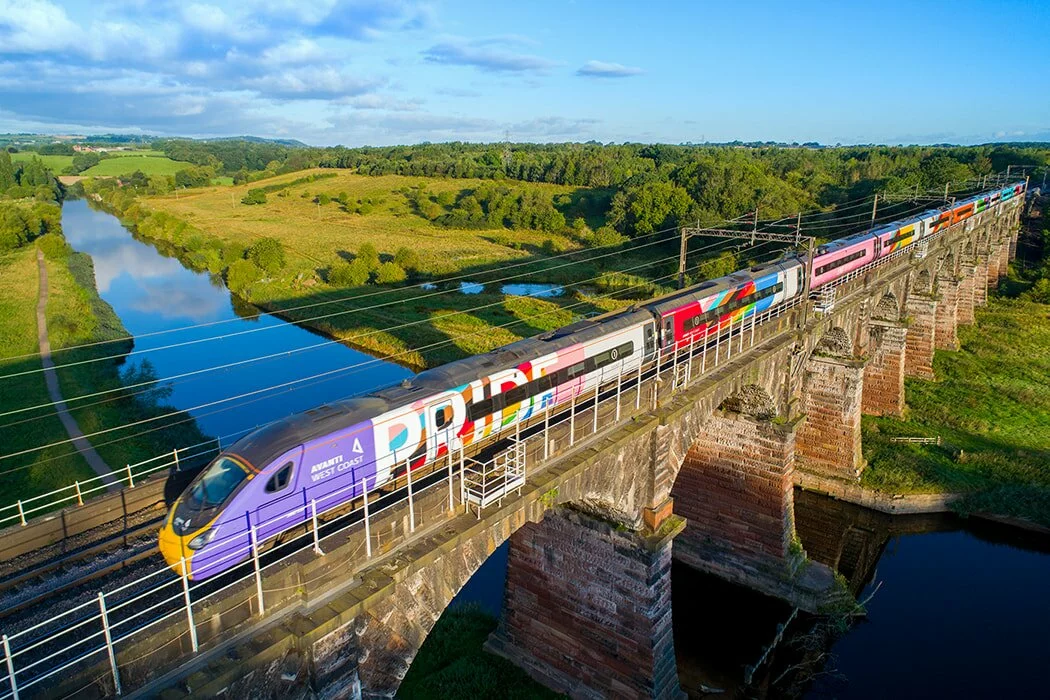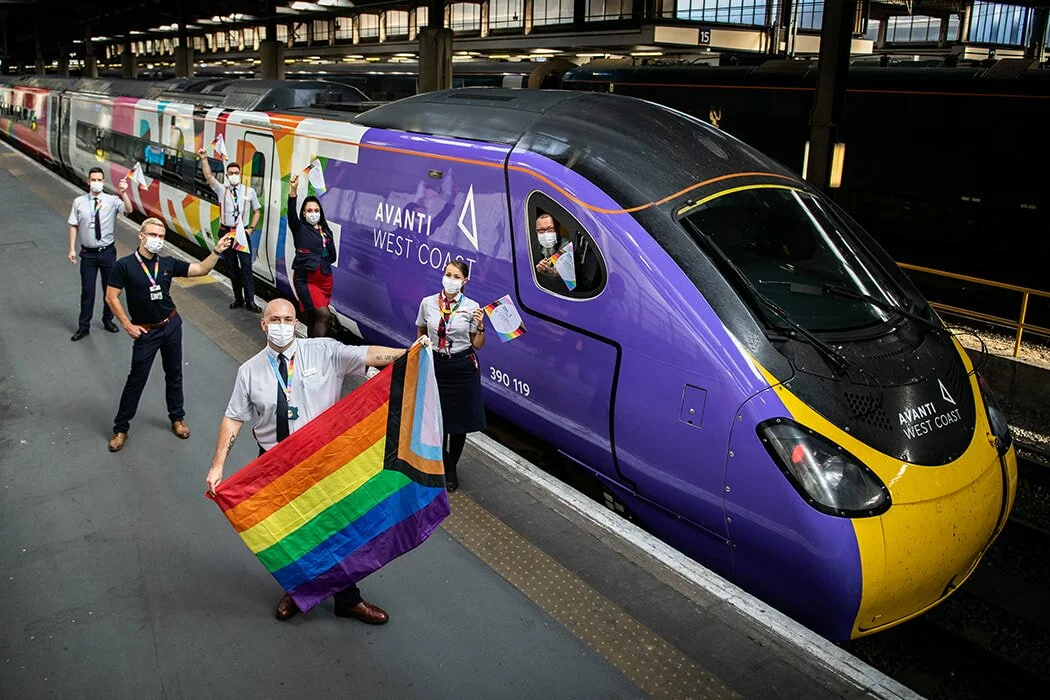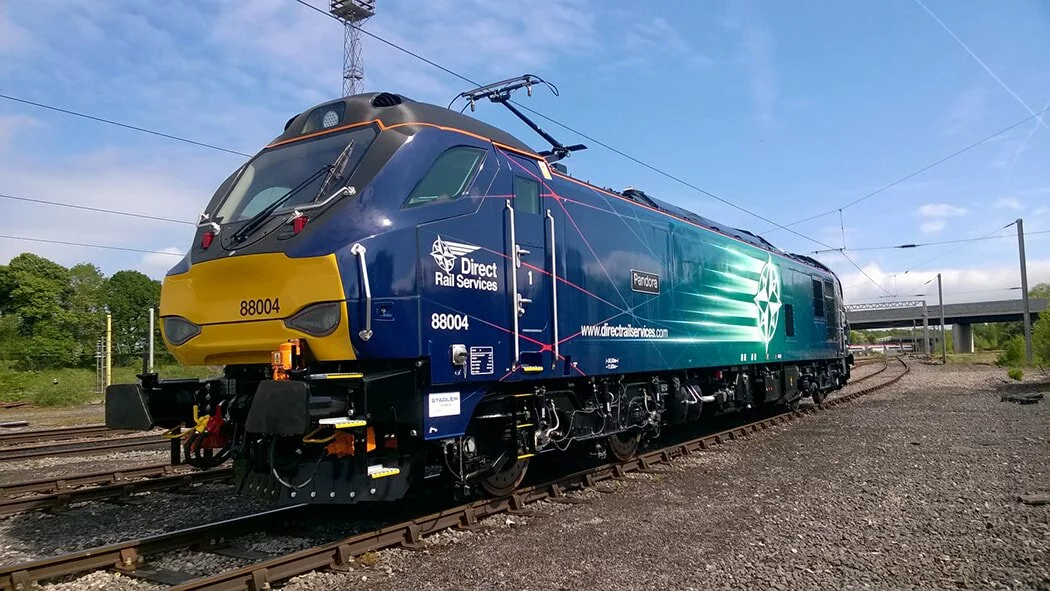- Home Page
- Fleet News Ramblings
- SKM News Views & Blog
- Behind The Picture
- Contact us
More Lockdown challenges for bus and rail operators6/1/2021 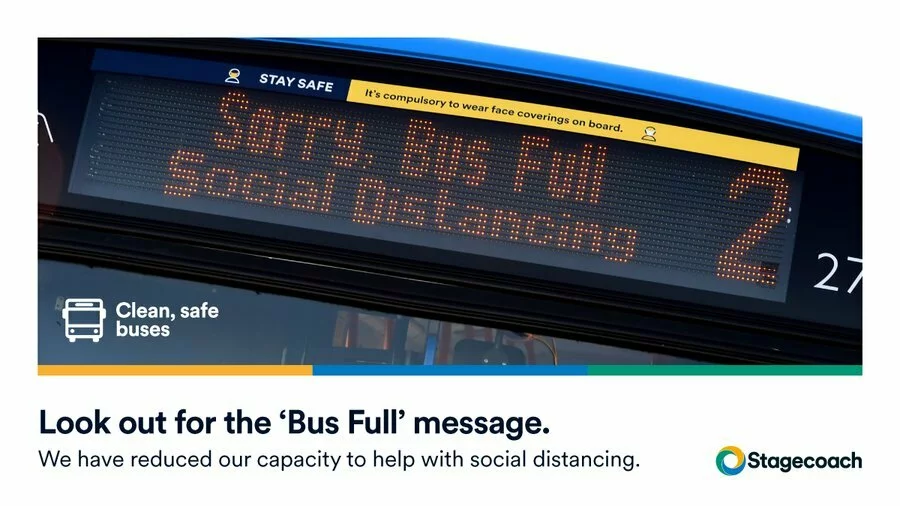
Just a few days into 2021 and the UK has been plunged into yet another period of Lockdown. The exact restrictions vary across England and the devolved nations but it again brings uncertainty for transport operators.
Lockdown 3 in England, or L3 as we will refer to it, came into play at Midnight on Wednesday 6th January 2021 having been announced by Prime Minister Boris Johnson two days earlier. There are some exceptions to the first lockdown (L1) last year but we can expect it to last for at least seven weeks and schools have again been closed, although as in L1 they remain open for children of ‘Key Workers’ The new strain of COVID-19 has to be the culprit for the massive increase in infections, as does an increase in household mixing. We can only hope that L3 along with the roll out of vaccinations will combine to fight the virus and allow a return towards normality and the kind of freedom we all previously enjoyed. I have no doubt that COVID-19 will not go away but the best result is that it is controllable. Almost ten months on there can be few people who are not tiring of the restrictions but we must stick to them. The effects of L3 will be felt by transport operators. The Government is already talking about drastically slashing train services. Some reports suggest that up to 50% of services nationwide could be cut seeing timetables again based on those seen during L1. Open Access operators Grand Central and Hull Trains are again suspending their services. Less than a day into L3 there are few signs of how bus and scheduled coach operators will respond. Bus operators continue to receive Government support but can that continue against the potential backdrop of passenger numbers falling again due to the ‘Stay at Home’ message. Given that the L3 will last a minimum of seven weeks our best guess is that passenger numbers will be closely monitored over the next week and a decision taken on what action should be taken. Like the suggested cuts to rail services it is not inconceivable that bus timetables will return to those that were operated during the first Lockdown. Let's not forget that capacity on trains and buses is still reduced to allow for Social Distancing, so the maximum carrying capacity remains limited. Both bus and rail operators had seen a recovery in business following the ending of L1 and the easing of restrictions last year but the growth fell well short of pre-COVID levels. Now it is likely that the growth curve will need to start all over again. There is no doubt in our view that transport operators will now have to re-write their 2021/22 business plans. One victim of L3 and the resultant reduction in business could be any plans to resume capital investment. Can new vehicle investment be justified? If the answer is no, and even if there is some kind of investment we believe it will be severely limited which means fewer lower emissions vehicles being bought and older higher emissions vehicles remaining in service. Away from scheduled public transport operations another Lockdown is the last thing that coach operators need. Many saw their business decimated last year with terminal results for some. It seems that for them 2021 has started in the same vain. The public transport industry has also suffered personally with staff contracting COVID and some losing their lives as a result. The daily figures are alarming and thoughts and go out to everyone who has suffered from COVID and our deepest sympathies go also to everyone who has lost loved ones, friends and colleagues to COVID. Our round up of news and musings from the last month....30/9/2020 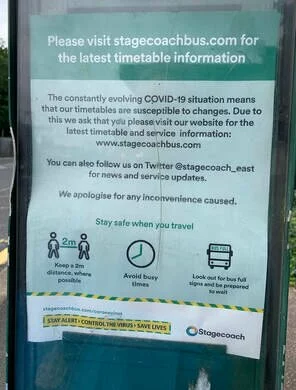
Where’s the timetable?
It has now been many months since the ‘essential travel only’ message for bus travel was dropped, but whilst some areas are operating over 90% of pre-COVID ‘lockdown’ services the number of passengers travelling is varied across the country. We hear that in some areas passenger numbers have been high, but in others previous bus users lack the confidence to return to using bus services. Add to that the number of people now working from home and no longer needing to travel to their workplace. Then there are those for whom ‘lockdown’ encouraged them to walk or extract the bike from the back of the shed. In many urban areas prospective passengers have been mostly kept up to date with ‘forthcoming departures’ from their nearest bus stop through real time screens, but the frequent service changes post-‘lockdown’ has flagged up examples where the updating of the database that feeds the real time system has been slow. But what about prospective passengers who use stops without real time information. At the start of ‘lockdown’ many had their timetables removed and replaced with a generic notice that pushed prospective users towards Apps and the internet for information. Perhaps I was naive to assume that as services returned to almost pre-COVID ‘lockdown’ levels proper timetables would re-appear at these bus stops. Not so! The result, for prospective bus passengers at these stops, they have little choice if they don’t have internet access. Just wait and hope that a bus will turn up. I have my suspicions that the removal of timetables means that some bus companies will hope that prospective passengers will forget the printed bus timetables were ever displayed. There again, with Government support is there any incentive for bus companies to increase their loadings? Meeting the schools transport challenge I must admit to being impressed at the way bus and coach companies have responded to the challenge of providing return to school services. It really was a trip into the unknown but we have not seen masses of ‘horror’ stories in the media. These arrangement will evolve as operators get a greater understanding of the school transport requirements but duplicate and scholars only services are, in my view, here to stay for some time. It seems that some operators have managed the return to school business through segregation with students using the upper deck with all seats in use and other passengers the lower deck where Social Distancing remains. What has been surprising is how some operators turn a scheduled journey into a scholars-only journey part way through the route. Whilst it may be legally allowed, it hardly encourages non-student travel. And by nature of the schools requirement it effectively bars non-students from peak time journeys. Transport tourism returns but faces challenging times It is pleasing to see how a number of transport-related tourism businesses have managed a phased return but with a significantly reduced footfall. During the early part of 2020 many of them were preparing for the start of the tourism season. ‘Lockdown’ meant they had to remain closed through what would be their busiest time of the year. Many of the attractions were able, in some cases at a considerable extra cost, to ‘tweak’ their offering and ensure they could offer a COVID-Secure environment for visitors. Where attractions did open it was in a ‘new normal’ was of operating. It is pleasing to see that heritage railways have been able to provide a limited offering which has afforded them at least some income. In recent weeks the North Yorkshire Moors Railway has been offering two return Pickering-Whitby services, but its intermediate stations remained closed. Our photo shows the railway’s BR Standard 9F 92134 heading for Pickering as it passes Moorgates heading south from Goathland.
Avanti West Coast makes its mark
Over the last few weeks we have received a number of updates from Avanti West Coast. The company confirms that 31 of its Pendolino trains have now received the Avanti West Coast cab vinyls – 39008/16/43/44/45/47/49/39/40 along with 390103/04/12/13/21/23/25/27/28/30/32/32/34/35/36/37/38/41/48/52/53/54/55/56. Pendolino 390119 had a special ‘Pride’ wrap applied during August. The refurbishment of the Super Voyager fleet continues at Ilford with sets 221101/05/06/08/09/11/13/15 all now completed with all of the company’s Class 221 units due to be refurbished by the 18th December 2020. Remaining with the Super Voyager trains, all of them have now been modified with welsh language announcements.
Award for Direct Rail Services
Direct Rail Services (DRS) has won the Community and Environmental Responsibility award at this year’s Rail Freight Group awards. The prestigious Rail Freight Group awards showcase excellence in all aspects of rail freight and the benefits it brings to the country. This year the awards took on a different feel as they were virtual but it didn’t dampen spirits or detract from the fantastic work happening across the industry. The Community & Environmental Responsibility award recognises initiatives that demonstrate environmental improvement, for instance, cutting noise, improving air quality and developing new rail freight flows which reduce road congestion, or otherwise reducing environmental impacts. The judges commended the way DRS has launched a Zero Harm campaign to protect employees, assets and the environment, the company’s extensive work within the community and charitable endeavours, the ground-breaking use of their Class 88 bi-mode locomotives, modifying its Motherwell depot to reduce noise for local neighbours, and its work on using digital displacement hydraulics to reduce emissions which could have a significant impact across the industry. Avanti West Coast prepares to resort more stations to its network from 7th September 202017/8/2020 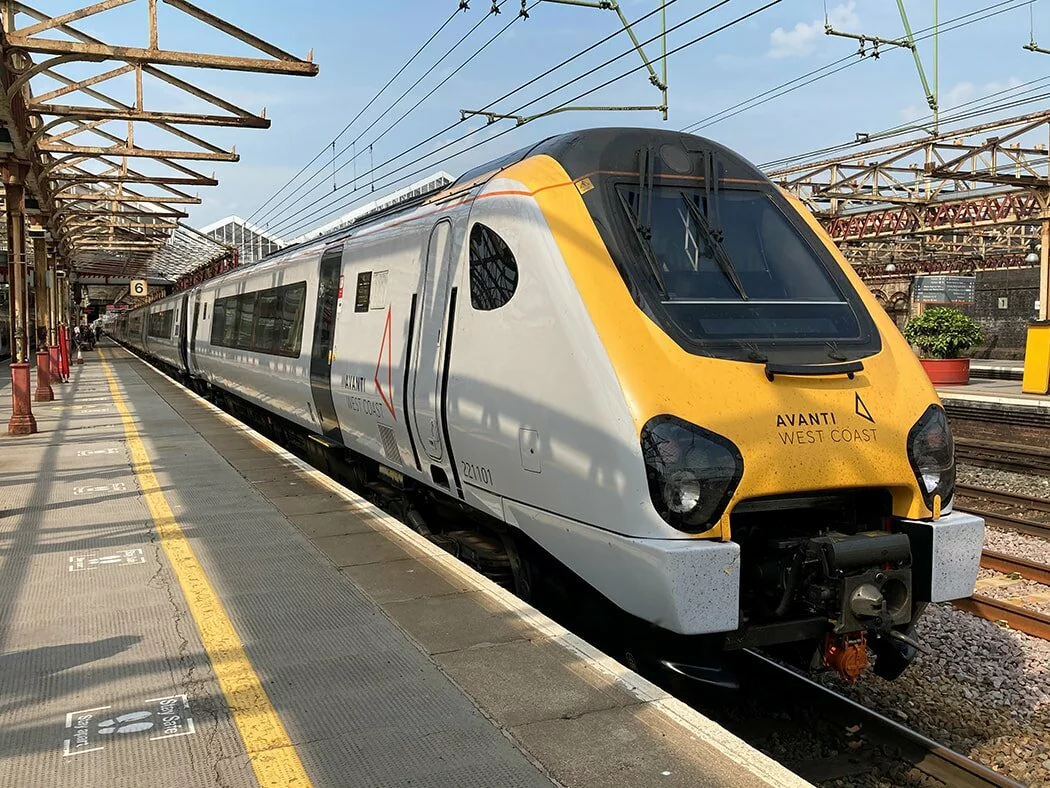 © Avanti West Coast © Avanti West Coast
It’s been a while since we caught up with Avanti West Coast so to put that right we bring news that from the 7th September 2020 the company plans to increase its timetable to around 90% of pre-COVID levels.
The timetable uplift will restore through links to and from London to Shrewsbury, Wrexham, Chester and North Wales, Blackpool and Edinburgh. Shrewsbury, Wrexham, Blackpool and Edinburgh will all see the return of direct Avanti West Coast services to and from London for the first time since lockdown measures were enforced. North Wales will also be served by one train in each direction between Holyhead and Euston, supplemented by a shuttle service along the coast from Crewe. Chester will have three direct trains to London Euston. In addition, the additional early morning services between Milton Keynes to London that started in July together with the late afternoon return services will continue. Following the September timetable uplift, Avanti West Coast will be operating 285 services each day on Monday to Fridays up from 277 a day. The relatively small uplift in total services a day is explained by the fact that many of the extra through journey opportunities will be created by the extension of existing services. An Avanti West Coast spokesperson told SKM: “These additional services will mean more room for social distancing onboard. We would like to remind customers to book ahead, reserve their seat and wear a face covering whilst at the station and onboard our services.” The spokesman added that Avanti West Coast has “seen a steady growth in reservations and loadings in the past month” Latest information suggests that the company is operating at around 40% of our its latest social distanced reservable capacity. With 227 seats available, out of 589, on an 11 car Pendolino the number of passengers currently travelling is averaging around 80-90 per train. On board services are also now returning with the reintroduction of the First Class at-seat service on Pendolino services. The range of items to purchase from the onboard shop has also increased. The 7th September changes means that: + Shropshire will be served by the 06:39 Shrewsbury to London Euston (with calls at Telford and Wellington, and the 18.23 return service from London Euston. + Blackpool North will have two direct services to and from London via the West Midlands, in addition to one early morning service from Birmingham and a late evening service back to the West Midlands. + Edinburgh Waverley and Haymarket will have seven services to London Euston (six in the return direction), which will also restore direct links between the Scottish capital and the West Midlands. + Wrexham’s direct service to London Euston will depart at 07:03, returning at 17:10. + A direct service from North Wales to London Euston will depart Holyhead at 06:55, returning north at 17:10. + Chester’s three services for London will depart at 07:35, 08:35 and 14:35 respectively. Important Announcement concerning Steven Knight Media28/7/2020
Like many small businesses we have felt the effect of the COVID-19 ‘lockdown’. Specifically this meant we had to delay the publication of Stagecoach East Midlands and Stagecoach Oxfordshire Fleet Handbooks (now due in August 2020) and the Stagecoach East Fleet Handbook (which we expect to publish in October 2020).
We had planned to publish these three books in March 2020 and the publication delays are also as a result of short notice changes to the fleets and the cancellation of investment plans in new vehicles. A number of retailers through whom we sell our books were also closed. All are now open and we thank them for their continued support. As a result of these challenges and their effects on us we have reluctantly taken the decision to cease publication of commercially-produced Fleet Handbooks and other publications once the Stagecoach East Fleet Handbook is published. We will continue to provide updates to the Stagecoach, Go North East and East Yorkshire Fleets through Fleet Ramblings on our website and will also, for the foreseeable future, continue to produce the monthly allocation documents. We will also be continuing with our media and PR work but feel the time is now right to start the journey towards full retirement. What happened to the new simplified Stagecoach livery plan?7/7/2020
The COVID-19 restrictions and the fact that several OpCos closed their paint shops means that there acre currently far fewer buses in the new Stagecoach liveries that would have been expected.
Where repaints have taken place they are now appearing with full branding, after a period when buses were pushed into use in the new livery but without company logos. We here that in a couple of areas this confused intending passengers. We still haven’t seen one of the Stagecoach ‘Local’ vehicles in the flesh, but we are still unsure on what the livery brings to the Stagecoach brand. It now seems that the livery template has been refined and recent repaints are generally to a single design. There was a ‘tweak’ in recent weeks to the ‘magic bus’ livery in Manchester where the amber design on the back has been omitted. What has become evident is that some previous liveries and brands have been allowed to remain, whilst the three basic ‘new livery’ designs have been expanded. We still hear of some older vehicles being painted in the former corporate ‘beach ball’ scheme. We now think that the following generally summarises the generic Stagecoach UK livery plan: 2000 corporate ‘beach ball’ livery - discontinued but still being applied to some older vehicle types 2000 corporate ‘electric hybrid’ livery - being discontinued 2000 corporate ‘InterConnect’ - off white with purple and violet graphics (used in Lincolnshire.Norfolk) 2000 corporate Stagecoach Gold - gold/dark blue (was being discontinued but appears to now being retained) 2020 Stagecoach ‘Local’ livery - off white with blue, amber and ocean green graphics 2020 Stagecoach ‘Specialist’ livery - off white with ocean green graphics 2020 Stagecoach ‘distance’ livery - all over amber 2020 Stagecoach ‘magic bus’ livery (Manchester) - off white with blue graphics and white stars Lakes Connection/Lakesider - Green-based with Lake District branding (Cumbria fleet) Cambridgeshire Busway - ocean green with white Busway branding Cambridge electric bus - white with ocean green graphics and electric bus branding Manchester electric bus - ocean green with electric bus branding Oxford Tube - Red with branding Megabus UK - Blue with ‘megabus’ branding (replaces darker blue with ‘megabus.com’ branding So much for the three livery variations plus Megabus and Oxford Tube announced earlier this year and the list above doesn't include the myriad of local identity liveries and branding currently widely used across the Stagecoach UK operation. Big challenges for bus operators but are they always putting the passenger first?7/7/2020
It is good to see bus services returning to ‘close to’ pre-lockdown service levels in terms of timetabled frequency, but social Distancing remains a limiting factor for passenger numbers.
We hear that some operators are having to duplicate some journeys but generally two double deck buses can cater for 40 passengers - a huge reduction on the 150 seats normally available. We have heard prospective passengers say they are fearful of using the bus because they don’t know if they will be able to get home again, or will be forced to wait for a bus with vacant seats. We have said it before but with vastly reduced carrying capacity bus operators will struggle to maintain a viable business with many still unclear on what any Government subsidy will look like and when they will see it. We also hear of passengers complaining that they cannot get on buses when there were ‘dozens of empty seats’. That poses the question. ‘Are operators doing enough to publicise Social Distancing seating capacities? The answer is yes, and no. Online and App-based information is available, but generally nothing exists at bus stops. Why, where real time displays are provided cannot they be programmed with scrolling messages. Perhaps it is because most are operated by local authorities and not the bus companies. In a recent discussion with a former bus industry colleague we discussed the removal of roadside timetables in some areas. In place are notices advising prospective passengers to consult the App or go online. My colleague doing his best Victor Meldrew impression said: “don't get me started on the switch from printed timetables to journey planners via technology. the benefit is to the operator not the customer!” We do wonder whether the bus stops that have lost their timetables for a ‘look online’ poster will ever see a proper timetable being returned. Let’s not forget that as restrictions are eased and more passengers are allowed on buses operators more than ever will need to attract passengers back. And it will be a real challenge. During ‘lockdown’ people have been walking or cycling and even taking to their car. Then there are those who have been working from home. That presents bus operators with another unknown. How many commuters have they lost to home working? With all these challenges we suspect that the major groups will be reviewing their back office and admin functions and we have even heard of an operator looking at dispensing with its remaining revenue protection roles. What we can predict is that the bus industry going forward will be looking to reduce cost and that means that redundancies and job losses are likely to take place. We wonder how long it will be before service frequencies are reviewed. Will be see seven minute frequencies become ten minutes and ten minute frequencies become 12 or 15 minutes. Such actions will save costs through reducing vehicle and driver requirements. We hope the bus industry can bounce back, but being realistic that bounce back could take many years. That said the post-COVID bounce back will be a challenge for many industries and businesses in many sectors. Will be ever experience life as we knew it pre-‘lockdown’ again? Post-lockdown musings7/7/2020
The last few months have been, err… strange.
We have gone through ‘lockdown’, shortages in the supermarkets, a block on leisure activities, the rise of home haircuts, queues for the shops, reduced opening hours and essential activity only at banks to name but a few. Then there has been the lack of clarity at times from Government. Announcements made but then having to wait for the guidelines. Lots of instructions but are they guidelines or statutory instructions. What seems like ‘U’-Turn after ‘U’-Turn and senior figures failing to understand instructions and guidance. We think, though, we have missed the change to the requirement of ‘double yellow lines’ on our roads. We are sure that at some stage the law must have been changed to signify that ‘double yellow lines’’ demotes a parking or unloading area. The in narrow streets cars should be parked opposite each other. We are also convinced that the definition of footpath has also been changed to “an area where cars can be parked” As a result roads have become “and area where pedestrians are allowed to walk round cars on the footpath”. The serious comment here, though, is that we hear of buses being delayed due to poor parking, buses unable to pull into bus stops due to poor parking and in some cases sections of bus routes having to be omitted due to parked cars. If bus companies didn’t have enough challenges to deal with…… What next for bus companies as they adapt to a 'new' normal1/7/2020 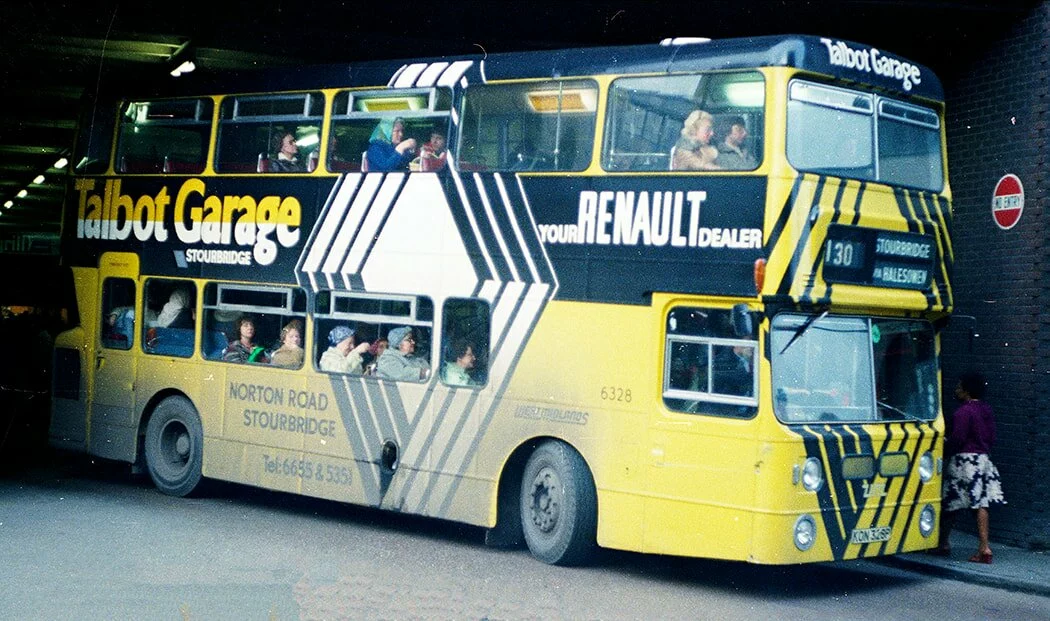 Back in the 1970s this West Midlands PTE Fleetline was promoting Renault Cars, a strange thing to do for a company whose business was to encourage travel by public transport. It gave a sort of ‘Don’t use this bus, buy a car’ message. But in the new post-COVID ‘normal’ of 2020 could advertising cars on buses provide bus operators with a much needed income boost given that the current average capacity of a double deck bus is around 20 passengers and revenue could be into single figures as a percentage of pre-lockdown normal? © Steven Knight Media Back in the 1970s this West Midlands PTE Fleetline was promoting Renault Cars, a strange thing to do for a company whose business was to encourage travel by public transport. It gave a sort of ‘Don’t use this bus, buy a car’ message. But in the new post-COVID ‘normal’ of 2020 could advertising cars on buses provide bus operators with a much needed income boost given that the current average capacity of a double deck bus is around 20 passengers and revenue could be into single figures as a percentage of pre-lockdown normal? © Steven Knight Media
When I worked in the bus industry in the 1970s and 1980s it would have been unthinkable to be peddling the message of ‘please do not travel’ or use buses only if essential.
That is no way to run a business and keep it afloat. But it seems that is what our Government wants the bus industry to do. Bus we should remember the 1970s and 1980s when it was commonplace for companies to promote cars and dealerships on their buses - including all over adverts. Could a return to those days generate some much needed income? In normal circumstances such an idea in 2020 would be absurd, but these are not normal times. After almost three months of running a bare minimum of service most of the bus operators are increasing frequencies. Costs are returning to somewhat approaching pre-lockdown levels but passenger numbers and the important revenues are not. Yes, there is the promise of Government support, but we are hearing from some quarters that bus companies are still unsure on how much they will receive and indeed when they will receive it. In the meantime they are expected to continue to ramp up their bus services to near normal service levels. But let’s remember that service levels may be near normal but that carrying capacity is not. A 76-seat double deck generally has capacity for 20 Socially-Distanced passengers. On a midibus, such as an Enviro 200 the capacity drops to around ten and on a Solo is it really worth putting it on the road when capacity is around seven. The Government needs to make clear what the support package is, how it will be allocated and when it will be paid. Then there is the reimbursement of Concessionary Travel - not that many pass holders can use the bus given the reduced seating capacity. Local Authorities are also struggling to balance the books. Will this also mean that they will struggle to pay bus operators in a timely way. From our observations and the latest set of revised timetables from many operators we suspect that bus service levels in many areas are returning to around 90% of normal but that doesn’t mean that they are carrying 90% of normal passenger loadings. Our estimate is that it could be nearer to 215-20% of normal and at best in some areas pushing 25%. Again that does not mean that 25% of normal passenger numbers means 25% of normal revenue. I stand corrected here but my assumption is that in many cases current revenues in percentage terms is in single figures when compared against pre-lockdown levels. If my calculations are anywhere close, then bus operators will need a massive cash injection to keep them afloat. My prediction is that capital investment, as we have seen in recent years, will become a thing of the past. New vehicle orders will be paused as the oldest vehicles in fleets - which ordinarily have been due for replacement - will remain parked up and will not be required. By the end of the year will we start to see service levels cut? Let’s not forget the advice has been to walk or cycle (or use the car). We are no longer being urged to use the bus. I hope that my prediction is wrong, but I would be surprised if it is….. A face covering from Transdev that matches the bus seat29/6/2020 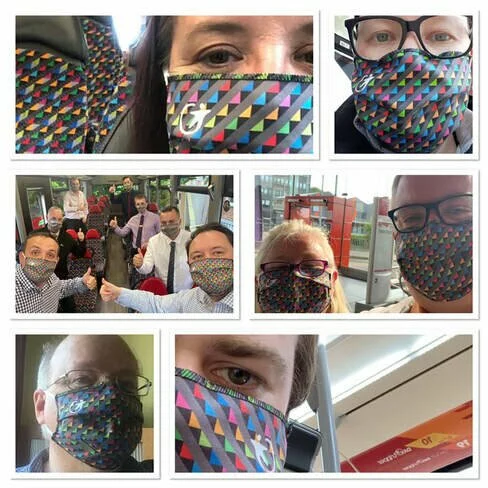
The requirement to wear face coverings whilst travelling on buses and also whilst at the railway station and on trains has prompted bus group Transdev to launch its own, unique, face coverings. We think though that we should remind passengers wearing them that they rick blending into the seat! The face coverings carry the same design pattern as the seats on some of the buses!
Alex Hornby, Transdev UK CEO told us: “The latest government guidance is a simple ‘ask’ of our customers, so everyone can travel with peace of mind. We’ve always set out to make our buses places people want to be seen, and the same unique touch of style we’ve become famous for has gone into creating unique face coverings, which are be available to our customers from at our bus stations in Yorkshire and Lancashire”. Recognising that the Transdev face coverings could become a much sought-after item, Transdev is also making them available through an on-line ‘pop-up shop’. Visit shop.transdevbus.co.uk. Proceeds from the sale of the 'All the colours of Transdev' face coverings will go to NHS Charities Together. The Transdev face coverings are washable and reusable. They cost £2.50 each from Transdev travel shops and £4.50 each from the online shop. We do think this is a great way of promoting an important travel message so well done to Alex and his team. Where do we go next?24/6/2020
The last few months have seen us all adapting to life under ‘lockdown’ and then the gradual easing of restrictions. Businesses have been hit, millions of workers placed on the Government’s Furlough scheme, high streets emptied of shoppers, hotels and holiday areas closed and the transport sector faced with the biggest loss of passengers it have ever faced.
National Express and Megabus pulled the plug on its operations. Local bus services were reduced to the bare minimum and we were told that they were for ‘essential travel’ only. The same message applied to train services. Despite train and local bus services returning to pre-‘lockdown’ levels, Social Distancing means that carrying capacities have been drastically reduced. AS typical double deck bus can currently only seat 20. A massive reduction from the normal 70+ carrying capacity. In England the last few weeks has seen a quickening of the easing of ‘lockdown’. From July 4th the hospitality sector can re-open providing it is COVID-secure. The ‘Staycation’ is back on the cards (in England at least). The two metre rule is being relaxed (in England at least). There is confusion. The rules in Wales, Northern Ireland and Scotland differ. Already we hear that there is the view (wrongly) amongst some groups that ‘lockdown’ is over. It is not. It has been eased - there is a difference. We all need to play our part to enable UK plc to get back to some semblance of normal. It could be many months - even years - before we return to the pre-COVID normal according to the experts. What we do know is that we need to get used to a ‘new normal’. For public transport use that currently means essential travel only and the wearing of face coverings. We have been appalled, however, to see people discard face coverings on the ground when they get off the bus, or leave the station. Everybody needs to play their part. Remember the actions you take protects me. The actions I take protects you. If we all play our part we will all be taking the steps towards a more accessible and inclusive public transport provision. We should all be aware that we are perhaps entering the most dangerous part of the COVID pandemic. If we let our guard down we risk COVID-19 ‘spikes’ and the real risk of a major second wave of the virus which could lead to another total lockdown. We personally doubt that transport operators would be able to sustain another ‘lockdown’. We do hope that the actions we are all taking will provide real barriers to the transmission of the COVID-19 virus and that bus, coach and train services will be able to apply to take the gradual steps that are needed to get back to normality. For coach operators running tours and excursions we believe the return towards normality will be more of a struggle. Social Distancing means that coach tours may initially be unviable but there is also a big ‘confidence’ issue to overcome. We wish all bus, coach and train operators and their staff well as they ramp their services and tour programme up over the coming months. The effects of the ‘lockdown’ have also impacted on Steven Knight Media. |Having announced last year that we were ‘winding down’ our book publishing we had three more Fleet Handbooks planned covering the Stagecoach East, East Midlands and Oxfordshire fleets. In normal circumstances these would have been published as soon as we had details of Stagecoach’s 2020/21 new vehicle plans. The COVID-19 ‘lockdown’ meant that generally investment in new vehicles had been slashed. Over 50% of the three fleets were delicenced or mothballed. The ‘new normal’ for these companies is only now emerging and there are many temporary arrangements in place. As a result all we can say is that we will look at publishing these books in late-Summer/early Autumn 2020. The books are fully designed and ready to print but we will continue to update then right through until the day, and the hour, that the files are sent to the printers. We will even substitute photographs is we receive something more newsworthy in the intervening period. During the main ‘lockdown’ period there we received few messages on fleet information and many of our industry contacts were either furloughed or were fully focused on the day job. That is now improving and we are able to provide regular Fleet Ramblings updates. We would like to thank all the correspondents who have continued to provide us with information and also the photographers who have supplied us with photographs which they have also allowed us to use in Fleet Ramblings. To fill the gap, we have published a number of archive images, which we hope you have enjoyed viewing. As Fleet Ramblings is now ramping up with regular updates, we have now ceased the archive images postings. We have continued to update the Fleet Allocation documents on a regular basis, where we have been able to confirm details. There are a few companies where information is still awaited but we hope over the coming month to have the information up-to-date for all Stagecoach companies. Over the last twelve months we have received numerous requests to return to a single document for the Stagecoach company allocations. From July that is what we will do. We will ensure that the file size is the smallest possible to enable fact downloading. Finally, thank you all for your support. |
Steven KnightSteven Knight is a Transport Specialist who has over 40 years experience in the bus and rail industries as well as in specialist transport journalism. He is a member of the Chartered Institute of Journalists. ArchivesJanuary 2021 |
 Create your own unique website with customizable templates.
Create your own unique website with customizable templates.
- Home Page
- Fleet News Ramblings
- SKM News Views & Blog
- Behind The Picture
- Contact us

